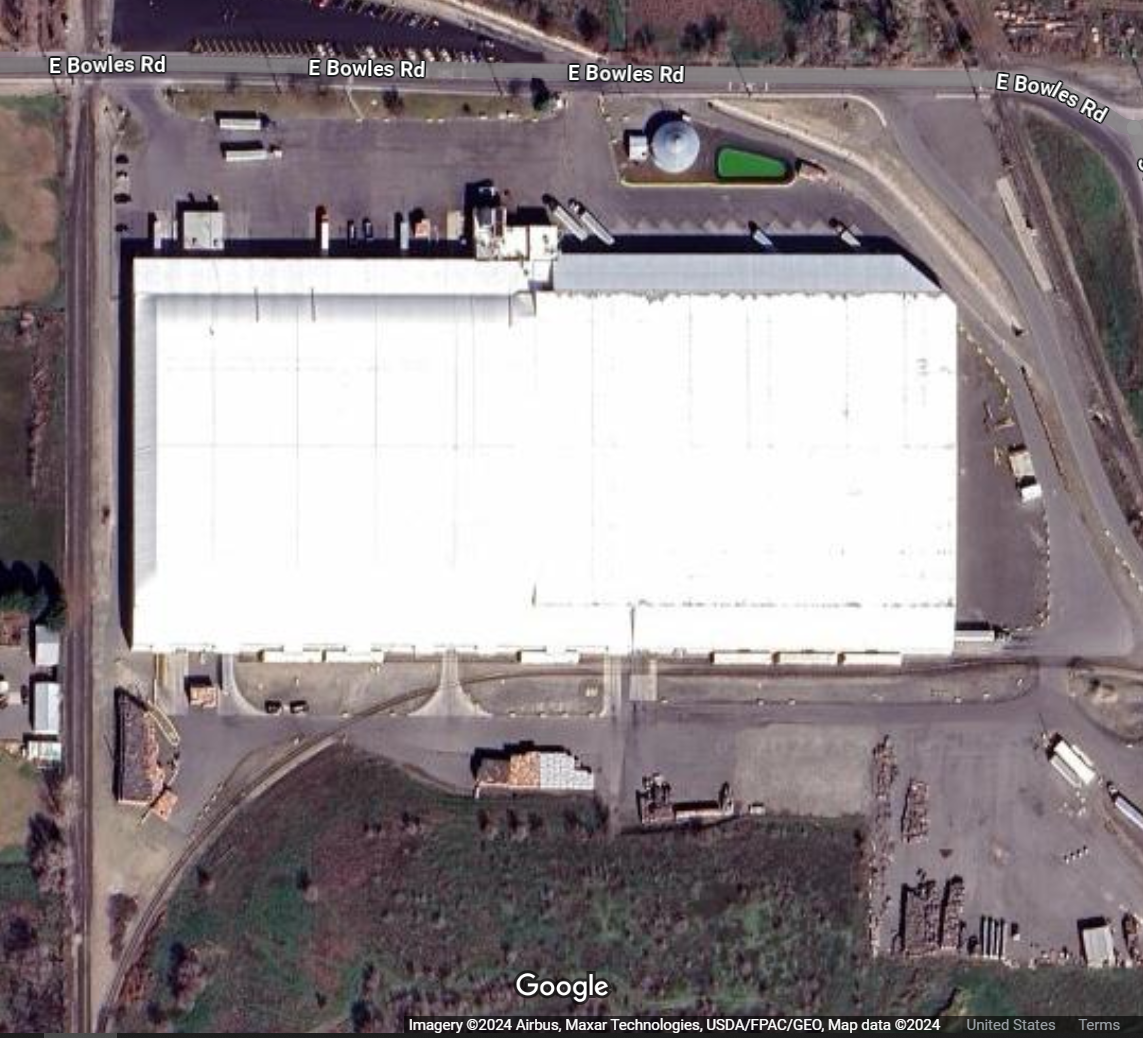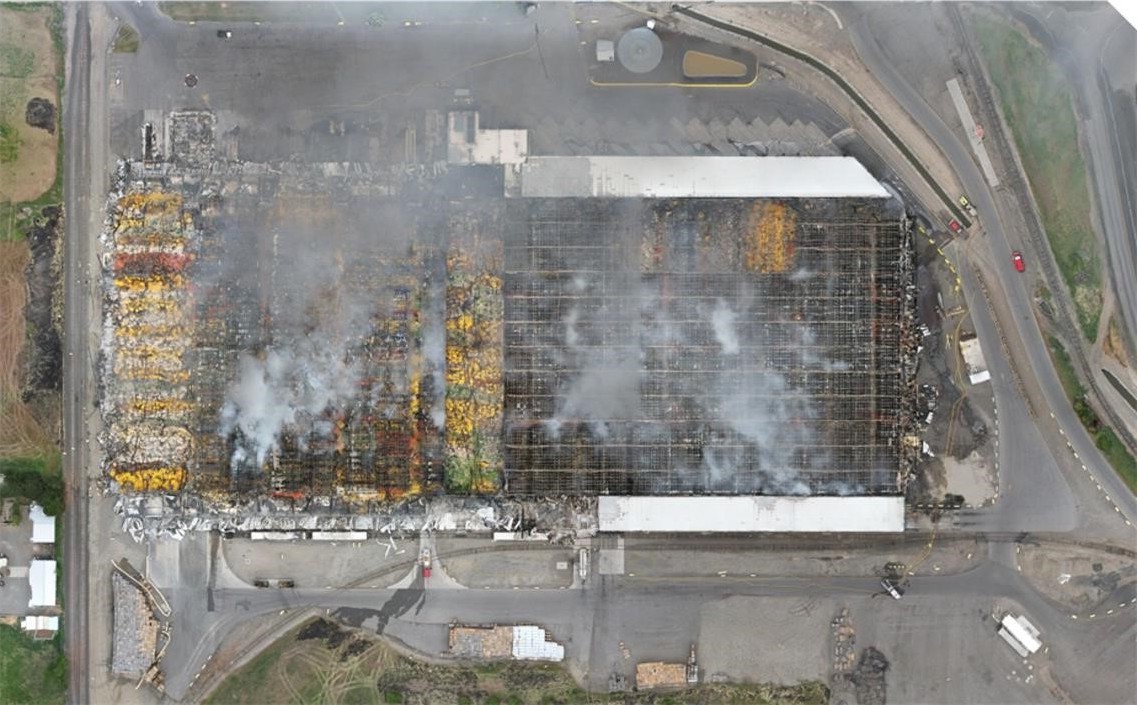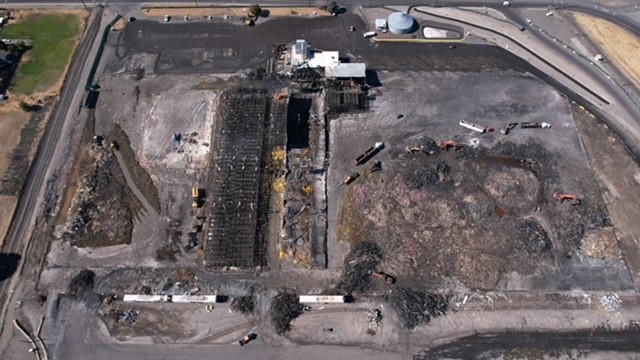

Kennewick Response
Kennewick Response
A Message from Lineage
Lineage’s top priority continues to be the health and safety of our employees, partners, and the communities in which we live and operate. We recognize the profound impact the fire at our Kennewick facility adjacent to Finley has had on the community and everyone who lives here. Many of our Lineage team members are Finley and Kennewick residents themselves, and both our local and national leadership are focused on marshaling resources to accelerate fire recovery efforts.
We are doing everything we can to suppress the fire as quickly as possible and have been working closely and around the clock with dozens of local, state, federal and private institutions to accomplish this. Since Lineage has taken central command of the site over from the local Benton County Fire District #1, our immediate priority has been coordinating with Signal Restoration Services to remove debris that will give firefighters better access to our facility to put out the fire and abate any unsafe conditions. The focus is on clean-up activities toward the center of the warehouse to provide safe access to areas currently unreachable by the firefighters. Signal also continues to receive clearances to clean-up additional areas of the facility that were previously inaccessible.
We also understand concerns expressed by Finley, Kennewick and surrounding area community members that they haven’t felt Lineage’s presence in the public discussion. Please know it isn’t because we haven’t wanted to be highly communicative; rather it’s because it is a very complex and fluid situation that we take very seriously, and we didn’t want to provide you with incomplete or misleading information. In effort to deliver appropriate updates in a responsible and meaningful way, we’ve worked alongside local officials, including the Benton County Fire District #1, the Benton-Franklin Health District, the Benton County Commissioners, the Benton Clean Air Agency, the Washington State Department of Ecology, the WA Department of Health, and many other partners, to coordinate the response at every stage of this incident while deferring to their guidance and expertise in providing information to the public.
As the fire continues to burn and smoke persists, we know that you may have a variety of questions. The following is intended to serve as a resource to provide answers to your questions. We will update this page as new information becomes available.
An Update from Lineage on June 20, 2024
We are pleased to share that we’ve fully extinguished the fire at our Kennewick facility adjacent to Finley. As a result of the significant progress in debris removal made and continuous firefighting in collaboration with the Benton County Fire District, our teams on the ground were able to access the remaining hot spots and put out the fire.
We expect cleanup efforts will continue for several weeks. The photos below show the facility before the fire, immediately following the fire, and debris removal progress as of Tuesday, June 18.
Additionally, Lineage is delivering supplies to the Benton-Franklin Heath District for distribution to Finley and Kennewick residents including masks, box fans, box fan filters, air purifiers, and air purifier filters. A drive-thru event is planned for Friday, June 21. Please see the Benton-Franklin Health District’s Lineage Fire Response page for details and timing.
Once again, we thank our local officials and partners who we have worked with closely at every stage of this incident, and we look forward to continuing to work together as we continue work on the site.
Google Earth photo of facility prior to fire:
Drone photo of the facility shortly after the fire:
Drone photo of site cleanup efforts on 6/18/2024:
Frequently Asked Questions
In response to recent questions received from community members since introducing this resource page, we have added to our FAQs. We hope you find the following information helpful.
-
As originally shared by The Benton-Franklin Health District, the BFHD Environmental Health Team in partnership with the Washington State Department of Health and the WA Department of Ecology have installed PurpleAir sensors in the Finley area. These sensors will be working 24/7 to gather air quality data that is easily accessible to the public in real-time by visiting the EPA Fire and Smoke Map (airnow.gov). This new data complements current and forecasted air quality information available on the Department of Ecology's Washington Air Monitoring Network webpage. As another resource, the Washington Air Quality Guide for Particle Pollution (PDF) graphic provides health recommendations for the different color-coded air quality categories based on EPA's Air Quality Index (AQI).
-
Originally built in 1991 and later expanded in 1997, the approximately 525,000 square-foot warehouse was fully dedicated to the cold storage of food. Within the facility, we ensured the freshness of a variety of agricultural products and ready-to-ship vegetables, ranging from potatoes, corn, carrots, peas and more. Lineage’s role within the food supply chain—more specifically the cold chain—is to ensure cold food, such as produce, meat, poultry and dairy, is safely stored and transported through the “middle mile” – from growers and producers to manufacturers and retailers, and ultimately, to the plates of millions of homes across the country.
We continue to partner with all local, state and federal agencies, including the Benton County Fire Department, the Benton-Franklin Health District, the Benton County Commissioners, the Benton County Clean Air Agency, the Washington State Department of Ecology, and the WA Department of Health to provide access to the site for any additional testing needs.
-
There were no bulk hazardous materials or chemicals stored at our facility. Our Kennewick warehouse, located adjacent to Finley, was exclusively used for the cold storage of food. While our on-site freezing technology utilized anhydrous ammonia as a refrigerant for cold storage, we want to assure the community there was no ammonia detected in the atmosphere during the fire or in the days following. As part of standard protocols, ammonia detectors were installed on-site at the onset of the fire by the Washington State Department of Ecology, and at no time has there been ammonia detected in the atmosphere. In partnership with Benton County Fire District #1, the liquid anhydrous ammonia at the facility was safely removed from the scene in the days after the fire began.
-
With a building approximately 12 acres in size, safety for first responders is a critical factor, as firefighters are unable to safely get to the areas of the facility that are still smoldering. According to information shared by Benton County Fire District #1, even with its tallest fire truck, firefighters cannot reach much of the center of the building with water. To date, firefighters have put about 36 million gallons of water onto the fire.
As of May 24th, the local Benton County Fire District #1 handed central control of the scene over to Lineage, and we have contracted Signal Restoration Services to spray water on debris as construction equipment opens new areas. While the Benton County Fire District #1 has departed the scene to ensure they also are serving other emergency response needs in the community and region, they continue to respond and assist in urgent situations of periodic fire flare ups resulting from the unearthing of dry materials and debris. We have seen and will continue to see a significant improvement with smoke shedding as we are able to get to the nucleus of the structure and suffocate hot spots better each day.
-
Our immediate priority is coordinating with Signal Restoration Services to remove debris that will give firefighters better access to our facility to put out the fire and abate any unsafe conditions. This includes directing clean-up activities towards the center of the warehouse, providing safe access to areas currently unreachable by the firefighters. With approximately 90,000 tons of debris, consisting of concrete, metal, plastic, electronics and food, throughout a nearly 12-acre facility, Signal is deploying 47 heavy-duty construction vehicles (e.g., bulldozers, excavators, etc.) facilitating 60-70 of truckloads departing the site daily. Based on assessments of structure stability, existing debris and available work area, this is the maximum capacity of vehicles we are confident in deploying to ensure the safety of construction crews and first responders.
-
We are committed to working as expeditiously as possible and while we’d like to operate 24 hours per day, there are a few factors that prevent continuous activity, with the health and safety of on-site support crews chief among these considerations. Operating in darkness adds risk to the specially trained and certified operators and ground staff, but we are currently working extended hours as conditions and safety conditions allow—and we’re installing additional lighting towers to further improve evening visibility and extend the hours of operation. Additionally, given the complicated nature and immense scale of the clean-up efforts amidst smoldering debris and active flare-ups, moving forward with clearing or treating certain areas of the fire sometimes requires approval by various agency investigators and inspectors who aren’t available 24/7. However, we are working closely with local officials and continue to maximize and accelerate our clean-up and fire suppression efforts as safely as possible.
-
According to Benton County Fire District #1, the location and size of the area that has been burning at the center of the 12-acre building is too large for hoses to fully reach the center of the fire, even with its tallest fire truck at full blast, or for the rain to have made enough of an impact. The Benton County Fire District #1 and Signal Restoration Services have been monitoring for flare-ups where their hoses can reach and responding accordingly, but it is too dangerous to send firefighters on foot through the unstable structure to reach more central areas. Demolition and debris removal is underway to help clear a path for firefighters to safely reach and extinguish smoldering areas.
Additionally, prior to Lineage safely securing access to our on-site well and pumps through our clean-up activities and with approval by agency officials and investigators, water access for firefighters was a challenge. Finley has no domestic water and there are restrictions on access to ditch water from the Columbia Irrigation District and domestic water from the City of Kennewick. The Benton County Fire District #1 also previously stated it refrained from using too much irrigation water in order to protect the livelihood of local farmers and ranchers that rely on it, pulling from the irrigation canals only when necessary and with permission.
-
No. As a result of our clean-up activities to date, Lineage has secured access to our on-site well and have worked with fire investigators for approval of use of our water pump powered by on-site generators we installed, which are now being used to fill the tanks on the multiple water cannon trucks Signal Restoration Services is utilizing for fire suppression. We also petitioned the Columbia Irrigation District to remove restrictions on ditch water usage and provide increased access, which we now have with limitations on use when the temperature is above 85 degrees Fahrenheit.
-
According to information shared by Benton County Fire District #1, the state will not provide air resources because the fire is not spreading. Since it is contained within the building’s footprint, it does not pose a threat to homes, wilderness areas or natural resources. Also, there is the additional concern that water drops could further destabilize the structure of the building.
-
Our Kennewick warehouse, located adjacent to Finley, covered approximately 12 acres and served as a central cold storage solution for the region’s agricultural products and ready-to-ship vegetables, ranging from potatoes, corn, carrots, peas and more. While the fire has caused a disruption to the food supply, we've marshalled many resources both internally and externally to respond quickly, diverting millions of pounds of food to keep the food supply chain running to alternate facilities, retailers and community tables throughout the region.
-
The cause of the fire is still under investigation. No foul play is suspected. Lineage has been working in partnership with the Benton County Fire District #1, several fire origin experts and investigators to determine what started the fire.
-
Lineage’s top priority continues to be the health and safety of our employees, partners, and the communities in which we live and operate, and we have been working closely with local officials, emergency responders and area partners to address the situation. We value the guidance and expertise of the Benton County Fire District #1, the Benton-Franklin Health District, the Benton County Commissioners, the Benton Clean Air Agency, the Washington State Department of Ecology, and the WA Department of Health, along with many additional partners, and we have worked alongside them to coordinate the response at every stage of this incident. As we coordinate our efforts in alignment with local officials, our immediate priority is coordinating with Signal Restoration Services to remove debris as quickly as possible.
-
We are proud to share there were no injuries at the facility as a result of the fire, and we’ve actively been relocating our workforce to other Lineage facilities in the area, having offered all 82 of our team members positions elsewhere, with the vast majority (upward of 90%) already back at work.
-
Our immediate priority is coordinating with Signal Restoration Services to remove debris and put out the fire. Conversations surrounding the future of our Kennewick facility will be our focus following the resolution of our current fire suppression and clean-up efforts.
-
While the fire caused an initial disruption to the food supply, we've marshalled many resources both internally and externally to respond quickly, diverting millions of pounds of food to keep the food supply chain running. To date, we’ve ensured redistribution of food that would have otherwise been stored at our Kennewick facility to alternate facilities, retailers and community tables throughout the region.
Smoke From Fires – Health Information Frequently Asked Questions
As sourced from and originally shared on the Benton-Franklin Health District Lineage Fire Response resource webpage, outdoor smoke contains very small particles and gases, and these particles can get into your eyes and lungs where they can cause health problems. The following information has been adapted from the Smoke From Fires | Washington State Department of Health. The same guidance for wildfire smoke also applies to the Lineage Kennewick Fire. Please understand that Lineage provides health information below that is found at publicly-available sources as indicated. Lineage does not endorse or make any representation as to the accuracy of these statements, and Lineage does not provide any medical advice. If you have any questions regarding your health, please seek assistance from your medical provider.
-
According to the Benton-Franklin Health District, exposure to smoke from fires can cause or worsen several health problems that range from minor to severe. When smoke is present, the worst symptoms more often occur in people with chronic conditions, though everyone can have symptoms or health problems. Some symptoms include:
- Eye, nose, and throat irritation (burning eyes and runny nose).
- Fatigue.
- Headache and coughing.
- Wheezing and shortness of breath.
- Aggravation of existing conditions, particularly heart and lung diseases, with symptoms like asthma attacks, chest pain, or irregular heartbeat.
- Mental health concerns and psychological stress.
-
According to the Benton-Franklin Health District, inhaling smoke is harmful to everyone. It's essential to reduce exposure and monitor symptoms during smoke events. Minor symptoms like sore throats and headaches are common with lower smoke levels, but as levels increase, especially for sensitive groups, health impacts can become severe. Those at higher risk include:
- Individuals with lung diseases (e.g., asthma, COPD)
- People with recent respiratory infections (e.g., COVID-19, pneumonia)
- Those with heart or circulatory problems (e.g., heart failure, coronary artery disease)
- People with a history of heart attack or stroke
- Diabetics, due to potential undiagnosed cardiovascular issues
- Children (18 and younger) with developing lungs
- Seniors (65 and older) with potential undiagnosed heart or lung diseases
- Pregnant individuals and their fetuses
- Smokers with likely reduced lung function
- Outdoor workers with prolonged smoke exposure
- People of color and indigenous groups facing institutional and structural discrimination
- Those with limited healthcare access
-
The Benton-Franklin Health District points to the following resources:
- Washington Smoke Information website (also known as the Smoke Blog) – Check current and forecasted wildfire and smoke locations. This is the one-stop-shop for all your information for wildfire season.
- Department of Ecology's Washington Air Monitoring Network webpage – Current and forecasted air quality information.
- Washington Air Quality Guide for Particle Pollution (PDF) graphic provides health recommendations for the different color-coded air quality categories based on EPA's Air Quality Index (AQI).
- Mobile apps are also available:
- Ecology's Washington Air Quality Network mobile site offers a web app download. The "Air Quality WA" mobile app is available for Apple or Google/Android.
- EPA's AirNow – Get current and location-specific information about air pollution, including the Fire and Smoke map.
- EPA's Smoke Sense – Get current and location-specific information about smoke, learn about health impacts, and participate in a community science project.
- Check local air quality reports, such as those from your local clean air agency, and listen to your local news stations to stay informed.
-
According to the Benton-Franklin Health District:
- Stay updated on air quality Interactive Maps (wa.gov)
- Limit outdoor physical keep activities light.
- Stay indoors with cleaner air:
- Close windows and doors unless it's too hot (see cooling tips below).
- Use HVAC systems and HEPA air cleaners, or DIY filters (see filtration tips below).
- Avoid adding to indoor pollution:
- No burning candles, incense, or wood.
- Avoid sprays, diffused oils, and air fresheners.
- Limit broiling, frying, and using gas stoves.
- No smoking or vaping indoors.
- Only vacuum with HEPA filters; avoid sweeping.
- Set HVAC to recirculate mode.
- Avoid gas or propane heaters.
- Create a cleaner air room (see EPA video).
- During better air quality periods, open windows and fresh air intake.
- If home air quality is poor, seek cleaner air elsewhere.
- If outside briefly, consider wearing a fitted N95 mask Wildfire Smoke and Face Masks Factsheet (wa.gov)
- Follow your healthcare provider’s advice if you have asthma or other lung diseases.
-
According to the Benton-Franklin Health District, keeping cool without air conditioning during smoky, hot weather can be challenging. Heat-related illnesses can develop quickly and be life-threatening. Here are some tips:
- Close windows, curtains, and shades during the day; use portable fans.
- Minimize stove and oven use during peak heat.
- Take cool baths or showers but avoid extreme temperature changes.
- Use ice packs, cool water foot baths, wet rags, or misting near a fan.
- Stay hydrated with water; avoid sugary or alcoholic drinks.
- Visit cooler indoor places for a few hours; call 211 for cooling centers.
- Track air quality and open windows when it improves.
- Only open windows when it's cooler outside and create cross-drafts if possible.
- For more details, see the handout "Cooling indoor spaces without air conditioning (wa.gov)" (PDF).
- To check your area's current and forecasted heat risk and find suggestion precautions, see CDC's HeatRisk.
-
According to the Benton-Franklin Health District, when avoiding hazardous smoke from fires, including wildfires, is not possible, N95 masks can offer some protection by filtering out most fine particles, though they don't block hazardous gases like carbon monoxide. These masks are available at hardware stores, home repair shops, and pharmacies. Proper fit and seal are essential for effective protection, so it's crucial to wear them correctly.
Masks are less effective for people with beards or facial hair, as they don't seal well. N95 masks aren't suitable for very young children and haven't been widely tested for them. Masks can make breathing harder, so individuals with lung or heart disease, or chronic illnesses should consult a healthcare provider before use. For more information, Wildfire Smoke and Face Masks Factsheet (wa.gov).
In indoor spaces where you can't keep windows closed or filter air, wearing an N95 mask for short periods can help if smoke levels are high, such as on public transportation or in public buildings. https://youtu.be/ctDtPzgSMiU
-
According to the Benton-Franklin Health District, children and youth are more sensitive to health effects from breathing in smoke because they breathe in more air than adults for their body weight. This increases their total dose of air pollution. The respiratory system also develops until about age 21. Children and youth with health conditions (including asthma and other lung diseases, heart disease, and diabetes) have a higher risk of emergency department visits and hospitalizations compared to children without health conditions.
Children and youth may also be at risk for declines in academic performance, neurodevelopmental problems, and chronic conditions in adulthood from air pollution exposure.
Parents:
- Read these tips on Children’s Health & Wildfires by Western States Pediatric Environmental Health Specialty Units (PEHSU).
- Read the interactive e-book, Sofia’s Story by PEHSU with your kids to help them understand health effects of wildfires.
- Read or watch the video Why is Coco Red by the EPA with your kids.
- For additional information, see Protecting Children from Wildfire Smoke and Ash, PEHSU (PDF)
Schools:
- The Washington Children and Youth Activities Guide (PDF) provides recommendations to protect children and youth from PM2.5 (fine particles in wildfire smoke). It can be applied to school, childcare, athletic practices and games, before and after school programs, camps, field trips, and other outdoor programming and activities.
- Follow guidance on keeping indoor air free of smoke in school and commercial buildings: Improving Ventilation and Indoor Air Quality during Wildfire Smoke Events (PDF)
- Summary Wildfire Smoke Guidance for Closing Schools (PDF)
Find additional technical guidance and risk communication resources for public health, air quality, and other officials in the Wildfire Smoke Partner Toolkit.
-
According to the Benton-Franklin Health District, smoke can affect animals’ health too. Animals with cardiovascular or respiratory disease are at increased risk from smoke and should be watched during periods of poor air quality. Look for the following signs of possible smoke irritation in animals. If your animals are experiencing any of these signs, contact your veterinarian.
- Coughing or gagging.
- Difficulty breathing, including open mouth breathing and increased noise when breathing or increased breathing rate.
- Eye irritation or redness and excessive watering.
- Nasal discharge.
- Fatigue or weakness.
- Disorientation or stumbling.
- Reduced appetite and/or thirst.
For pets:
- Keep them indoors as much as possible and avoid outdoor exercise. Keep outdoor bathroom breaks short.
- Spend time with them indoors and play games with them to keep them mentally and physically active.
- Pet birds are particularly sensitive to smoke and poor air quality and should avoid any outdoor exposure.
For more information, see Protect Your Pets from Wildfire Smoke, EPA (PDF).
For livestock:
- Limit their exercise and have plenty of fresh water always available, located near their feed or hay.
- Consider soaking hay to reduce inhalation of dust particles that might further irritate the airways.
- Limit dust exposure by feeding low-dust or dust-free feeds and sprinkling or misting the livestock holding area.
- Livestock may need several weeks to recover after a poor air quality event. Talk to your veterinarian about how to best monitor your animals and when to return to exercise, handling, moving, or transporting them.
For more information, see Protect Your Large Animals and Livestock from Wildfire Smoke (PDF).
Contact Us
For general inquiries, please email [email protected]
For media inquiries, please email [email protected]